Abstract
A three-dimensional inverse opal (3DIO) WO3 architecture has been synthesized via a simple sacrificial template method. Morphology features of the 3DIO were characterized by scanning electron microscope (SEM) and its structure was characterized by X-ray diffraction (XRD). The shrinking ratio of the PMMA spheres was ~28.2% through measuring the distribution of the PMMA spheres and 3DIO WO3 center-to-center distance between the spheres and macropores, respectively. Beyond that, the 3DIO gas sensing properties were investigated systematically and the sensing mechanism of 3DIO WO3 was proposed. The results indicated that the response of the 3DIO sensor possessed excellent sensitivity to acetone gas, especially at trace levels. The 3DIO gas sensor response was ~7 to 5 ppm of acetone and could detect acetone low to 0.2 ppm effectively, which was in close proximity to the theoretical low detection limit of 0.14 ppm when Ra/Rg ≥ 1.2 was used as the criterion for reliable gas sensing. All in all, the obvious satisfaction of the gas-sensing properties was ascribed to the structure of the 3DIO, and the sensor could be a promising novel device in the future.
1. Introduction
The Internet of Things has drawn considerable attention recently, and sensors, as the most important components of the Internet of Things, have been thoroughly researched [1]. Gas sensors have attracted significant attention with the environment attracting more attention [2]. Until now, many methods have been explored with respect to gas detection, [3,4,5,6,7,8,9,10] and metal oxide semiconductors have been extensively developed compared to others in the gas-sensing field, due to the advantages of high sensitivity, fast response and recovery, low detection limits, low fabrication cost, and simplicity in fabrication and measurement [11,12,13,14]. Additionally, it is generally known that the gas-sensing performance of oxide semiconductor sensors is strongly connected with the nanostructure morphology for the reactions of target gases and the sensing materials that are likely to take place at the sensing material’s surface. Therefore, the gas-sensing performance could be controlled effectively by changing the surface morphology of the oxide semiconductor materials [15,16].
Up to now, tremendous efforts have been devoted to designing different types of nanostructured morphologically-functional materials, such as electrospinning, solvothermal methods, sol-gel methods, magnetron sputtering, and vapor deposition methods. Although some progress has been made through controlling the pore size, surface area, porosity, and film thickness of the gas sensor, further exploration is necessary. The 3DIO semiconducting metal oxide nanostructure attracts more and more attention and research because of its near-ideal microstructures for gas sensors in recent years [17]. As a typical representative structure, the 3DIO structure usually shows a large surface area and a superior well-ordered porous architecture, all of which contribute significantly to plenty of active sites on the surface of the sensing materials and the effective reaction and diffusion of the target gas. As a consequence, these advantages make the 3DIO gas-sensing properties superior to other structures and many 3DIO semiconducting metal oxide nanomaterials have been prepared and studied [17,18,19,20,21]. Recently, Lee et al. prepared an n-type monolayer of 3DIO α-Fe2O3 and detected its sensing properties to NO2 [20]. The results showed that the prepared gas sensor demonstrates excellent gas sensing properties, besides showing a reversible switching from p- to n-type sensing property. Liang et al. successfully enhanced methanol gas-sensing properties though synthesis of 3DIO ABO3 perovskite-type oxides [22]. All of these studies indicated that the introducing of a 3DIO nanostructure might bring unique characteristics to the gas-sensing field.
Acetone, as a volatile organic compund (VOCs), exists extensively in our surrounding environment, such as building decoration materials, paint, glue, and in the laboratory, which is harmful to health and can lead to hazardous central nervous system dysfunction, bronchitis, and dermatitis. Beyond that, clinical data indicate that acetone concentrations in exhaled gas from healthy people are different from diabetics. Thus, real-time monitoring of acetone will be an extremely rewarding work in the environment and in health care. WO3, an important n-type semiconductor is extensively used in the gas sensor application area due to its advantages of a wide band gap, nontoxicity, and abundant sources [23]. Due to its physical and chemical properties, WO3 is widely applied to the analysis of H2, NO, NOx, NH3, acetone, H2S, etc. Thus far, a number of promising results have demonstrated the potential analysis of target gases using various nanostructures of WO3, such as nanorods, nanoflowers, nanowires, nanotubes, nanospheres, hollow spheres, and hierarchical structures. As one of the most used metal oxide gas sensors for the detection of acetone, WO3 sensors are capable of measuring acetone at the parts per billion (ppb) level, and could maintain a high signal-to-noise ratio in quite high relative humidity conditions, which is helpful to the detection of exhaled acetone gas [24]. Despite of all of the studies, to obtain high-performance WO3 gas sensors is still a challenge due to the controlling of WO3 nanostructures accurately with small crystals, and crafting superior surface properties is still a primary challenge for scientists. Considering the advantage of the 3DIO structure and the reported research of 3DIO WO3 is quite rare [25,26,27,28,29], in this paper, a sensor based on 3DIO WO3 is synthesized successfully and applied to acetone monitoring. The experimental results indicate that the 3DIO WO3 sensor demonstrates satisfactory gas-sensing performance and can monitor trace levels of acetone in a laboratory environment.
2. Experimental Section
2.1. Fabrication of WO3 Films
3DIO WO3 films were prepared by the sacrificial template method with a PMMA latex sphere opal as a template which was synthesized by methyl methacrylate [30,31]. The possible synthesis scheme of preparing the 3DIO WO3 films is shown in Figure 1 schematically, and descriptive processes were as follows: Firstly, the preparation of the PMMA spheres’ opal films: a stoichiometric amount of potassium persulfate was dissolved in deionized water before methyl methacrylate was added, and then the mixture was sintered for 90 min at 363 K in an oil bath to obtain PMMA latex spheres. Then, the obtained PMMA latex spheres were diluted with deionized water to form a 5% solid content colloid suspension. After that, the glass substrates, which were immersed into sulfuric acid for 2 h and washed with deionized water, were initially inserted into the aqueous colloid suspension vertically. Finally, the whole setup was placed in a 303 K oven for 24 h and then thin opal templates would self-assemble on the glass substrates with the evaporation of the water solvent. Secondly, the filling of the precursor solution: lacunas of the as-prepared thin opal templates were filled with the precursor solutions, which contained 0.08 M ammonium metatungstate hydrate and 0.26 M citric acid as a complexing agent by capillary force. Thirdly, the obtaining of the 3DIO WO3 films: the obtained films were placed in a tube furnace to remove the polymer spheres completely with a rising speed of 1 K/min to 773 K and sustained for 3 h, and the 3DIO WO3 films were finally obtained.
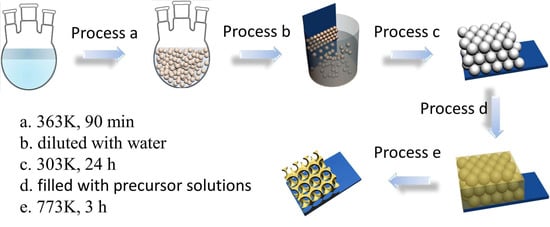
Figure 1.
Schematic view of the process to fabricate the 3DIO WO3.
2.2. Characterization
The morphology of the 3DIO WO3 film was inspected using a JEOL JSM-7500F field SEM (Tokyo, Japan) at an accelerating voltage of 15 kV with gold sputtered on the surface. The XRD patterns were conducted on a Rigaku D/max 2550 (Tokyo, Japan) using a monochromatized Cu target radiation resource (λ = 1.5045 Å) and the corresponding lattice constants of the samples were calculated by MDI Jade 5.0 software based on the XRD data. The gas-sensing properties were measured on a WS–30A system (Weisheng Instruments Co., Zhengzhou, China).
In this work, the different gas volume fractions of the target gases were obtained by the static distribution gas method, and the gas sources were 1000 ppm standard gas. The target gases’ preparation processes were as follows: Firstly, a 2.5 L volume glass chamber with stopper-rubber was pumped to a vacuum state. Then, a certain amount of the standard gas was injected into the glass chamber though a small mouth, followed by mixing with the atmospheric air. The injected amount of the standard gas can calculate by the following formula:
where V2 is the injected volume, V1 is the glass chamber volume, C1 (ppm) is the required gas concentration in glass chamber, C2 (ppm) is the 1000 ppm standard gas. For instance, 100 ppm (C1) required gas could be obtained by injecting 0.1 L (V2) 1000 ppm (C2) standard gas into the 1 L (V1) glass chamber.
V2 = V1 × C1/C2
When testing, the sensor with an extended line was put into the glass chamber, and then the sensor response reached a constant value. Thereafter, the sensor was removed from the glass chamber and placed in atmospheric air in order to recover to its original state. The response is defined as Ra/Rg for an n-type sensor (Ra and Rg are the resistance of sensors in air and in the target gas, respectively). The response and recovery times are defined as the time required to reach 90% of the final equilibrium value.
2.3. Fabrication and Measurement of Gas Sensing Properties
The 3DIO WO3 films were scraped off from the substrates by a metal blade, and then the powder was mixed with ethanol in a weight ratio of 5:1 (w/w) to form a paste. Next, the paste was coated on an alumina tube (4 mm in length, 1.2 mm in external diameter, and 0.8 mm in internal diameter) on which a pair of gold electrodes was previously attached. After the solvent was evaporated, the ceramic tube with the thin layer was sintered in an oven at 623 K for 2 h in order to enhance its mechanical stability. Soon after, a spring-like nickel-chrome (Ni–Cr) alloy (28 Ω) heating wire was inserted into the alumina tube, ensuring both substrate heating and operating temperature. The heating wire and the electrodes of the alumina tube were then welded on a tailor-made support, as shown in Figure 2a. Subsequently, the gas sensor was thermally aged with a heating voltage of 5 V for five days before the first measurement. Figure 2a,b show a photograph and a schematic of the gas sensor, respectively. Figure 2c shows the schematic diagram of the electrical circuit for measuring the 3DIO gas sensor. Vh is the heating power, Rh is the resistance of the Ni–Cr alloy wire (during testing, the working temperature of the sensor was adjusted by controlling the heating voltage Vh of the Ni–Cr alloy wire, and this control process relies on the W-30 system), Vc is the 5 V circuit power, and RL is the load resistance. The gas sensor properties in air or in the target gas are measured by monitoring the voltage output (Vout) of the load resistance RL. All tests are performed under room temperature.
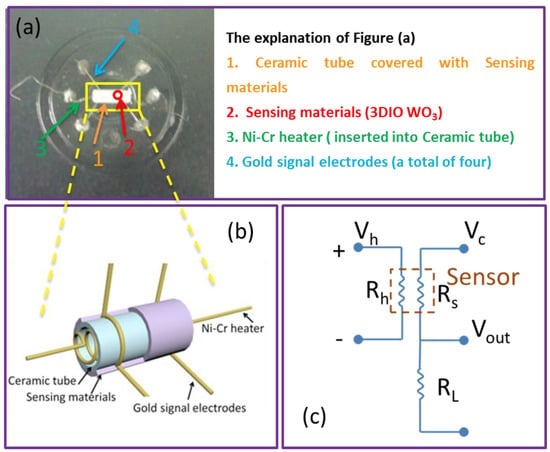
Figure 2.
(a) Photograph of the 3DIO WO3 gas sensor, (b) the schematic structure of the gas sensor, and (c) the schematic diagram of the electrical circuit for measuring the 3DIO gas sensor.
3. Results and Discussion
3.1. Morphological and Structural Characteristics
XRD was first implemented to confirm the phase composition and crystallinity of the 3DIO films. As shown in Figure 3, XRD typical pattern of 3DIO films proved that the crystal phase of the films was WO3, and the diffraction peaks were readily indexed to (002), (020), and (200) reflections of the monoclinic WO3 phase, which agreed well with the reported values from the Joint Committee on Powder Diffraction Standards card (JCPDS card 43-1035). Moreover, no other diffraction peaks were observed, indicating the absence of other impurities.
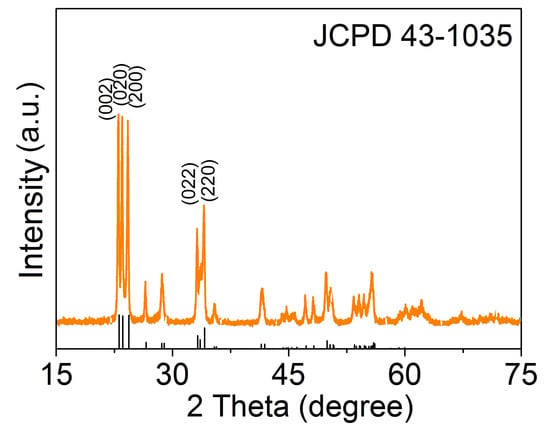
Figure 3.
XRD pattern of the 3DIO WO3 sample.
The morphologies and microstructure of the as prepared PMMA spheres opal films and 3DIO WO3 films are characterized in Figure 4 by using SEM. Figure 4a,b reveal that both the as-prepared PMMA sphere opal films and 3DIO WO3 films yield well-defined ordered nanostructures in a large range. To further investigate the polycrystalline structural nature of the 3DIO in Figure 4b, the SEM image of the 3DIO is enlarged and displayed in Figure 4c, which provides similar information of Figure 4b. As can be clearly seen, the 3DIO structure is similar to the hexagonal structure of honeycomb, which is one of the most stable structures in nature. This architecture ensures no collapse from pore and pore, which contributes to the spreading of the target gas. Moreover, as the red arrow points out in Figure 4a,c, the distributions of the PMMA spheres and th e3DIO WO3 center-to-center distance between the spheres and macropores are measured and shown in Figure 4d,e, respectively. Figure 4d,e show that 3DIO center-to-center distance is much smaller than that of the PMMA spheres (center-to-center distances are ~588.1 nm and ~422.2 nm, respectively), which can be attributed to the shrinkage of sphere diameter during calcination. Based on Figure 4d,e, further computing indicates that the shrinkage of the sphere diameter is ~28.2%, which is within the shrinking ratio of PMMA spheres.
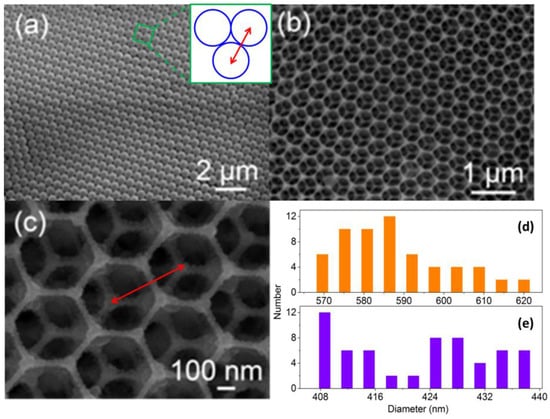
Figure 4.
SEM images of (a) PMMA sphere opal films, (b) 3DIO WO3 sample, and (c) the enlarged SEM images of 3DIO WO3 on the glass substrate. (d,e) The size distribution of the PMMA spheres and 3DIO WO3 center-to-center distance, and the size distribution were estimated by measuring 60 cells. The inserted picture of (a) is the enlarged scheme of the PMMA in the green box. The red arrows in (a,c) revealed the center-to-center distances of PMMA spheres and 3DIO WO3, respectively.
3.2. Gas Sensing Properties of 3DIO WO3 Sensors
The 3DIO nanostructure is a promising candidate as a gas sensor. The unique structure is capable of providing a large surface to volume ratio and good permeability, which is desirable for the adsorption and diffusion of target gases in sensor materials [17,22]. The 3DIO WO3 gas sensor was fabricated according to the above method and studied carefully. All of the sensors are placed under room temperature in an air atmosphere, and the whole testing process is also accomplished at room temperature. Considering the significant influence of the operating temperature on the sensitivity of gas sensors, the gas sensor was tested at different temperatures to determine the optimum operating conditions for acetone detection first [32]. Through controlling the heating voltage Vh of the Ni–Cr alloy wire in Figure 2c, various operating temperatures are acquired. Figure 5 depicts the response curve of the 3DIO WO3 gas sensor towards 5 ppm acetone gas as a function of the working temperature, and the lines are spline curves, which are used to show the relationships between the response and the working temperature vividly. It is observed that the 3DIO gas sensor shows typical n-type sensing characteristics—the response curve increases, at first, until reaching a maximum, and then decreases with the increase of the working temperature. Therefore, the gas sensor reacts most effectively at a particular temperature. In our case, the optimal working temperature is ~643 K and its corresponding response is ~7.0 for 5 ppm acetone.
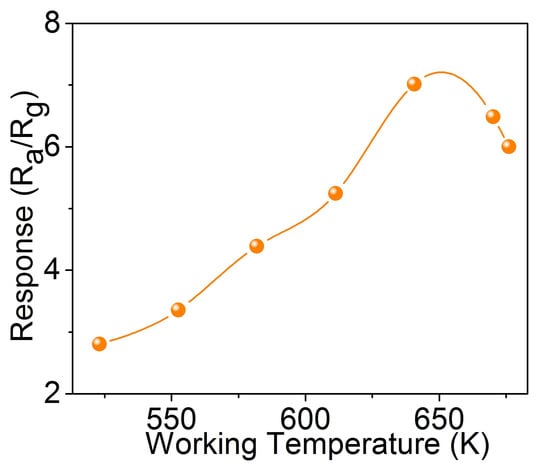
Figure 5.
Relationship of responses vs. the operating temperature of the 3DIO WO3 gas sensors to 5 ppm acetone. The lines are spline curves.
The selectivity indicator of the 3DIO gas sensor is tested by recording its responses at the working temperature of ~643 K to various testing gases, including ethanol, methanol, methanal, toluene, and ammonia at the concentration level of 5 ppm. The results shown in Figure 6a indicate that the 3DIO gas sensor shows the highest response to acetone, the lowest sensitivity toward methanol, and almost insensitivity to toluene. It is evident that the response of the 3DIO gas sensor to acetone against other gases exceeds two times, demonstrating the acceptable selectivity of the sensor to acetone. Moreover, the anti-interference performance of the sensor is tested in order to further investigate the gas sensor sensing performance indicators. As shown in Figure 6b, the responses are the sensor response when located in the mixed 5 ppm acetone and 5 ppm atmosphere of various gases. Comparing the response of Figure 6a,b, it is obvious that the response of the sensor when in acetone and another gas-mixed atmosphere is nearly equal to the response in acetone plus the response in another gas. In other words, the sensor response when in the mixed gases (gas one, gas two) is almost the same to the sum of the two responses when in gas one and gas two, respectively. This phenomenon could be attributed to complete reactions between the target gas molecules and adsorbed oxygen.
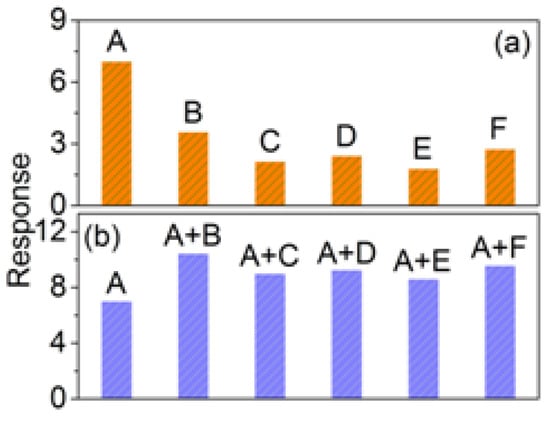
Figure 6.
(a,b) Selective test of 3DIO WO3 sensor for 5 ppm target gases at ~643 K respectively (A = acetone, B = ethanol, C = methanol, D = methanal, E = toluene, and F = ammonia).
Figure 7 shows the relationship of response vs. the acetone concentration ranging of 0.2–100 ppm at ~643 K. As can be seen, the response of the sensor increases dramatically when the acetone gas concentration is lower, and increases slowly, even saturated, when the acetone concentration is higher, which can be ascribed to the incomplete reactions between acetone and the 3DIO sensitive material of the sensor. With the acetone concentration increasing, a mass of acetone is covered on the surface of the semiconductor oxide sensing materials leading to a lower surface reaction which then leads to the slowly increasing speed of the response. Clinical data indicate that the exhaled acetone of diabetes exceeded 1.8 ppm, while for healthy individuals is only 0.3–0.9 ppm [33,34]. Moreover, detection of low concentrations of acetone is of great significance for environmental safety. Thus, more attention is focused on the gas sensing performance when detecting low concentrations of acetone, and the corresponding response of the low gas concentration in Figure 7a is enlarged, as shown in Figure 7b for convenience. As can be clearly seen, the response of the 3DIO gas sensor is positively proportional to the growth of the acetone concentration in the log-log plot. Note that the 3DIO gas sensor clearly shows response signals even when acetone concentration is as low as 0.2 ppm, which is in close proximity to the deduced low detection limit of acetone (0.14 ppm) when Ra/Rg ≥ 1.2 is used as the criterion for reliable gas sensing. Note that the experimental testing detection limit and the theory detection limit are all lower than the clinical data concentration of exhaled acetone, demonstrating the satisfactory performance of the 3DIO gas sensor. In addition, the slope in Figure 7b is calculated to be ~0.49 (nearly 0.5) stating the existence of macropores in the 3DIO sensing material, and the detailed explanations are shown in the literature published previously [28]. Furthermore, considering the scientific and reasonable evaluation of the performance of the sensor, the response, actual detection limit, and response (τres) and recovery (τrec) times, the sensing properties of the as-prepared 3DIO WO3 gas sensor in this study are compared with some other reported metal oxide semiconductor gas sensors and the results are demonstrated in Table 1 [35,36,37,38,39,40]. As the table shows, the overall performance of the 3DIO WO3 gas sensor is at a satisfactory level, indicating that the 3DIO architecture is beneficial in improving gas sensing properties and might be applied in the gas sensing field.
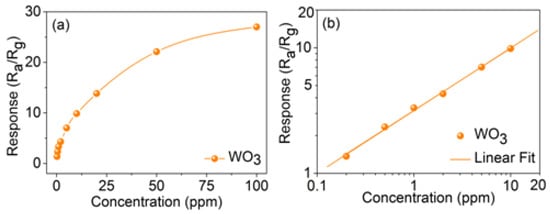
Figure 7.
Responses of the 3DIO WO3 sensor to different acetone concentrations in the normal coordinate system (0.2–100 ppm) (a) and log-log coordinate system (0.2–10 ppm) (b).

Table 1.
Comparison of the acetone gas sensing performances of some reported metal oxide sensors and the 3DIO WO3 sensor in this study.
In addition, the response performance of the 3DIO is further investigated at the working temperature of ~643 K. Figure 8 shows four dynamic processes of the sensor when exposed to different and the same acetone concentrations. As shown, the sensor responses all increased quickly when exposed to acetone gas and returned to its initial state when withdrawn from acetone gas within the four cycles. Additionally, the 3DIO sensor response increases linearly with the increase of acetone concentration, and is almost the same when detecting an identical concentration acetone gas. Based on the dynamic response curves of 5 ppm in Figure 8, the corresponding τres and τrec of the 3DIO sensor are calculated to be ~10 and 34 s, respectively.
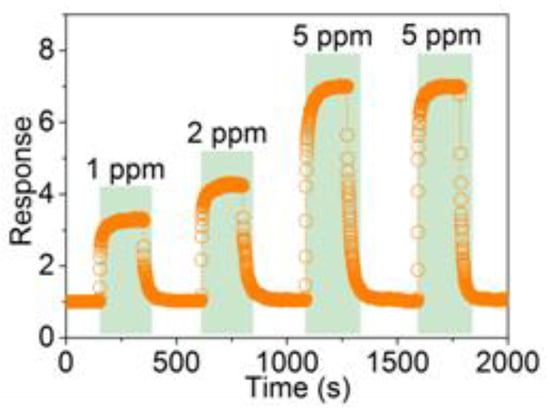
Figure 8.
Four period response curves of the 3DIO WO3 sensor to different acetone concentrations.
3.3. Sensing Principle of the 3DIO WO3
For the WO3-based gas sensing device, its acetone sensitivity performance is essentially similar to that of H2 [3,31,41]. In our case, when acetone is let in, H atoms are firstly dissociated from acetone molecules on the surface of the 3DIO, which then transform into H+ ions with the liberation of an electron e−, resulting in H+. Then, when two H+ approach an oxygen ion of WO3, the band between the W ion and the O ion will be weakened and then a localized H2O molecule can form. Upon formation of the localized H2O, two e− are released, which could lead to the decrease of the depletion region width and, consequently, the resistance of the film decreases. The progress can be described as follows:
WO3 + 2H+ + 2xe− ⇌ WO3−x·xH2O
Due to the gas sensor working temperature being quite high, it is possible that WO3−x·xH2O breaks down into WO3−x (WO3 with oxygen vacancies) and H2O vapors, as follows:
WO3−x·xH2O ⇌ xH2O + WO3−x
When the sensor is exposed to the air environment, oxygen vacancies will be occupied and WO3 will form, as follows:
2WO3−x + xO2 ⇌ 2WO3
Moreover, the satisfactory performances of the 3DIO gas sensor can be understood from two primary factors. Firstly, the slope in the log-log plot in Figure 7b is very close to 0.5, indicating the well-ordered porous architecture and almost no collapse and blocking of the 3DIO structure, which significantly contributes to the target gas diffusion and the charge transportation. In addition, the 3DIO possesses high surface-to-volume ratio and, thus, leads to complete reactions between the target gas molecules and the sensitive material. Secondly, Knudsen diffusion and molecular diffusion are possible owing to the unique 3DIO architecture showing both mesopores and macropores [42]. Therefore, the target gas could diffuse to the inner and the surface regions of the sensing films, which allows full reactions between the target gas and the sensing material, leading to the improvement of gas-sensing performance, accordingly.
4. Conclusions
In summary, 3DIO WO3 with monoclinic phase is prepared through a simple sacrificial template method and its gas-sensing properties are systematically investigated. In addition, the gas-sensing mechanism of the 3DIO architecture is discussed. The sensing results indicate that 3DIO WO3 shows satisfactory gas sensing performances to acetone gas, which could be attributed to the specific 3DIO structure with a large surface-to-volume ratio and excellent permeability. The response of the 3DIO sensor could up to ~7 when detecting 5 ppm acetone and the actual detection limit is 0.2 ppm, which is in close proximity to the theoretical low detection limit (0.14 ppm). Of particular note is both the experimental testing detection limit and the theoretical detection limit are all lower than the clinical data concentration of exhaled acetone, demonstrating that the as-prepared 3DIO sensor shows satisfactory gas-sensing properties and might be a promising acetone gas sensor used in environmental monitoring and noninvasive detection of illnesses in the future.
Acknowledgments
This work was supported by Doctor Fund of Tianjin Normal University (No. 52XB1601, 52XB1605).
Author Contributions
Ruiqing Xing conceived this study; Yang Du, Xiaonan Zhao and Ruiqing Xing performed the experiments, analyzed the data and wrote the paper; Xiu Zhang revised the paper.
Conflicts of Interest
The authors declare no conflict of interest.
References
- Kim, Y.H.; Kim, S.J.; Kim, Y.-J.; Shim, Y.-S.; Kim, S.Y.; Hong, B.H.; Jang, H.W. Self-Activated Transparent All-Graphene Gas Sensor with Endurance to Humidity and Mechanical Bending. ACS Nano 2015, 9, 10453–10460. [Google Scholar] [CrossRef] [PubMed]
- Wetchakun, K.; Samerjai, T.; Tamaekong, N.; Liewhiran, C.; Siriwong, C.; Kruefu, V.; Wisitsoraat, A.; Tuantranont, A.; Phanichphant, S. Semiconducting metal oxides as sensors for environmentally hazardous gases. Sens. Actuators B Chem. 2011, 160, 580–591. [Google Scholar]
- Ou, J.Z.; Yaacob, M.H.; Breedon, M.; Zheng, H.D.; Campbell, J.L.; Latham, K.; du Plessis, J.; Wlodarski, W.; Kalantar-Zadeh, K. In situ Raman spectroscopy of H2 interaction with WO3 films. Phys. Chem. Chem. Phys. 2011, 13, 7330–7339. [Google Scholar] [CrossRef] [PubMed]
- Zhu, Y.; Thangadurai, V.; Weppner, W. Garnet-like solid state electrolyte Li6BaLa2Ta2O12 based potentiometric CO2 gas sensor. Sens. Actuators B Chem. 2013, 176, 284–289. [Google Scholar] [CrossRef]
- Hong, W.; Chen, Y.; Feng, X.; Yan, Y.; Hu, X.; Zhao, B.; Zhang, F.; Zhang, D.; Xu, Z.; Lai, Y. Full-color CO2 gas sensing by an inverse opal photonic hydrogel. Chem. Commun. 2013, 49, 8229–8231. [Google Scholar] [CrossRef] [PubMed]
- Xi, G.; Ouyang, S.; Li, P.; Ye, J.; Ma, Q.; Su, N.; Bai, H.; Wang, C. Ultrathin W18O49 Nanowires with Diameters below 1 nm: Synthesis, Near-Infrared Absorption, Photoluminescence, and Photochemical Reduction of Carbon Dioxide. Angew. Chem. Int. Ed. 2012, 51, 2395–2399. [Google Scholar] [CrossRef] [PubMed]
- Zellers, E.T.; Batterman, S.A.; Han, M.; Patrash, S.J. Optimal coating selection for the analysis of organic vapor mixtures with polymer-coated surface acoustic wave sensor arrays. Anal. Chem. 1995, 67, 1092–1106. [Google Scholar] [CrossRef] [PubMed]
- Masuda, Y.; Itoh, T.; Shin, W.; Kato, K. SnO2 Nanosheet/Nanoparticle Detector for the Sensing of 1-Nonanal Gas Produced by Lung Cancer. Sci. Rep. 2015, 5, 10122. [Google Scholar] [CrossRef] [PubMed]
- Yamagiwa, H.; Sato, S.; Fukawa, T.; Ikehara, T.; Maeda, R.; Mihara, T.; Kimura, M. Detection of Volatile Organic Compounds by Weight-Detectable Sensors coated with Metal-Organic Frameworks. Sci. Rep. 2014, 4, 6247. [Google Scholar] [CrossRef] [PubMed]
- Zampolli, S.; Elmi, I.; Mancarella, F.; Betti, P.; Dalcanale, E.; Cardinali, G.C.; Severi, M. Real-time monitoring of sub-ppb concentrations of aromatic volatiles with a MEMS-enabled miniaturized gas-chromatograph. Sens. Actuators B Chem. 2009, 141, 322–328. [Google Scholar] [CrossRef]
- Ramgir, N.S.; Ganapathi, S.K.; Kaur, M.; Datta, N.; Muthe, K.P.; Aswal, D.K.; Gupta, S.K.; Yakhmi, J.V. Sub-ppm H2S sensing at room temperature using CuO thin films. Sens. Actuators B Chem. 2010, 151, 90–96. [Google Scholar] [CrossRef]
- Song, J.; Xu, L.; Xing, R.; Li, Q.; Zhou, C.; Liu, D.; Song, H. Synthesis of Au/Graphene Oxide Composites for Selective and Sensitive Electrochemical Detection of Ascorbic Acid. Sci. Rep. 2014, 4, 7515. [Google Scholar] [CrossRef] [PubMed]
- Li, X.; Li, X.; Chen, N.; Li, X.; Zhang, J.; Yu, J.; Wang, J.; Tang, Z. CuO-In2O3 Core-Shell Nanowire Based Chemical Gas Sensors. J. Nanomater. 2014, 2014, 8. [Google Scholar]
- Eranna, G.; Joshi, B.C.; Runthala, D.P.; Gupta, R.P. Oxide materials for development of integrated gas sensors—A comprehensive review. Crit. Rev. Solid State Mater. Sci. 2004, 29, 111–188. [Google Scholar] [CrossRef]
- Gurlo, A. Nanosensors: Towards morphological control of gas sensing activity. SnO2, In2O3, ZnO and WO3 case studies. Nanoscale 2011, 3, 154–165. [Google Scholar] [CrossRef] [PubMed]
- Sun, L.; Han, X.; Liu, K.; Yin, S.; Chen, Q.; Kuang, Q.; Han, X.; Xie, Z.; Wang, C. Template-free construction of hollow alpha-Fe2O3 hexagonal nanocolumn particles with an exposed special surface for advanced gas sensing properties. Nanoscale 2015, 7, 9416–9420. [Google Scholar] [CrossRef] [PubMed]
- Scott, R.W.J.; Yang, S.M.; Chabanis, G.; Coombs, N.; Williams, D.E.; Ozin, G.A. Tin dioxide opals and inverted opals: Near-ideal microstructures for gas sensors. Adv. Mater. 2001, 13, 1468–1472. [Google Scholar] [CrossRef]
- Xie, Y.; Xing, R.; Li, Q.; Xu, L.; Song, H. Three-dimensional ordered ZnO-CuO inverse opals toward low concentration acetone detection for exhaled breath sensing. Sens. Actuators B Chem. 2015, 211, 255–262. [Google Scholar] [CrossRef]
- Li, J.; Zhao, X.; Wei, H.; Gu, Z.Z.; Lu, Z. Macroporous ordered titanium dioxide (TiO2) inverse opal as a new label-free immunosensor. Anal. Chim. Acta 2008, 625, 63–69. [Google Scholar] [PubMed]
- Dai, Z.; Lee, C.-S.; Tian, Y.; Kim, I.-D.; Lee, J.-H. Highly reversible switching from P- to N-type NO2 sensing in a monolayer Fe2O3 inverse opal film and the associated P-N transition phase diagram. J. Mater. Chem. A 2015, 3, 3372–3381. [Google Scholar]
- D’Arienzo, M.; Armelao, L.; Mari, C.M.; Polizzi, S.; Ruffo, R.; Scotti, R.; Morazzoni, F. Macroporous WO3 Thin Films Active in NH3 Sensing: Role of the Hosted Cr Isolated Centers and Pt Nanoclusters. J. Am. Chem. Soc. 2011, 133, 5296–5304. [Google Scholar] [CrossRef] [PubMed]
- Qin, J.; Cui, Z.D.; Yang, X.J.; Zhu, S.L.; Li, Z.Y.; Liang, Y.Q. Synthesis of three-dimensionally ordered macroporous LaFeO3 with enhanced methanol gas sensing properties. Sens. Actuators B Chem. 2015, 209, 706–713. [Google Scholar] [CrossRef]
- Cheng, W.; Ju, Y.; Payamyar, P.; Primc, D.; Rao, J.; Willa, C.; Koziej, D.; Niederberger, M. Large-Area Alignment of Tungsten Oxide Nanowires over Flat and Patterned Substrates for Room-Temperature Gas Sensing. Angew. Chem. Int. Ed. 2015, 54, 340–344. [Google Scholar]
- Righettoni, M.; Tricoli, A.; Pratsinis, S.E. Si:WO3 Sensors for Highly Selective Detection of Acetone for Easy Diagnosis of Diabetes by Breath Analysis. Anal. Chem. 2010, 82, 3581–3587. [Google Scholar] [CrossRef] [PubMed]
- Jimenez, I.; Arbiol, J.; Dezanneau, G.; Cornet, A.; Morante, J.R. Crystalline structure, defects and gas sensor response to NO2 and H2S of tungsten trioxide nanopowders. Sens. Actuators B Chem. 2003, 93, 475–485. [Google Scholar] [CrossRef]
- Rout, C.S.; Ganesh, K.; Govindaraj, A.; Rao, C.N.R. Sensors for the nitrogen oxides, NO2, NO and N2O, based on In2O3 and WO3 nanowires. Appl. Phys. A Mater. Sci. Process. 2006, 85, 241–246. [Google Scholar] [CrossRef]
- Xiang, Q.; Meng, G.F.; Zhao, H.B.; Zhang, Y.; Li, H.; Ma, W.J.; Xu, J.Q. Au Nanoparticle Modified WO3 Nanorods with Their Enhanced Properties for Photocatalysis and Gas Sensing. J. Phys. Chem. C 2010, 114, 2049–2055. [Google Scholar] [CrossRef]
- Li, X.L.; Lou, T.J.; Sun, X.M.; Li, Y.D. Highly sensitive WO3 hollow-sphere gas sensors. Inorg. Chem. 2004, 43, 5442–5449. [Google Scholar] [CrossRef] [PubMed]
- Wang, C.; Li, X.; Feng, C.; Sun, Y.; Lu, G. Nanosheets assembled hierarchical flower-like WO3 nanostructures: Synthesis, characterization, and their gas sensing properties. Sens. Actuators B Chem. 2015, 210, 75–81. [Google Scholar] [CrossRef]
- Xing, R.-Q.; Xu, L.; Zhu, Y.-S.; Song, J.; Qin, W.-F.; Dai, Q.-L.; Liu, D.-L.; Song, H.-W. Three-dimensional ordered SnO2 inverse opals for superior formaldehyde gas-sensing performance. Sens. Actuators B Chem. 2013, 188, 235–241. [Google Scholar] [CrossRef]
- Yaacob, M.H.; Breedon, M.; Kalantar-zadeh, K.; Wlodarski, W. Absorption spectral response of nanotextured WO3 thin films with Pt catalyst towards H2. Sens. Actuators B Chem. 2009, 137, 115–120. [Google Scholar] [CrossRef]
- Lee, A.P.; Reedy, B.J. Temperature modulation in semiconductor gas sensing. Sens. Actuators B Chem. 1999, 60, 35–42. [Google Scholar]
- Ryabtsev, S.V.; Shaposhnick, A.V.; Lukin, A.N.; Domashevskaya, E.P. Application of semiconductor gas sensors for medical diagnostics. Sens. Actuators B Chem. 1999, 59, 26–29. [Google Scholar] [CrossRef]
- Shin, J.; Choi, S.-J.; Lee, I.; Youn, D.-Y.; Park, C.O.; Lee, J.-H.; Tuller, H.L.; Kim, I.-D. Thin-Wall Assembled SnO2 Fibers Functionalized by Catalytic Pt Nanoparticles and their Superior Exhaled-Breath-Sensing Properties for the Diagnosis of Diabetes. Adv. Funct. Mater. 2013, 23, 2357–2367. [Google Scholar] [CrossRef]
- Park, J.; Shen, X.; Wang, G. Solvothermal synthesis and gas-sensing performance of Co3O4 hollow nanospheres. Sens. Actuators B Chem. 2009, 136, 494–498. [Google Scholar] [CrossRef]
- Bai, S.; Liu, H.; Luo, R.; Chen, A.; Li, D. SnO2@Co3O4 p–n heterostructures fabricated by electrospinning and mechanism analysis enhanced acetone sensing. RSC Adv. 2014, 4, 62862–62868. [Google Scholar] [CrossRef]
- Zhang, Y.; He, W.; Zhao, H.; Li, P. Template-free to fabricate highly sensitive and selective acetone gas sensor based on WO3 microspheres. Vacuum 2013, 95, 30–34. [Google Scholar]
- Jia, Q.-Q.; Ji, H.-M.; Wang, D.-H.; Bai, X.; Sun, X.-H.; Jin, Z.-G. Exposed facets induced enhanced acetone selective sensing property of nanostructured tungsten oxide. J. Mater. Chem. A 2014, 2, 13602–13611. [Google Scholar] [CrossRef]
- Barreca, D.; Bekermann, D.; Comini, E.; Devi, A.; Fischer, R.A.; Gasparotto, A.; Maccato, C.; Sada, C.; Sberveglieri, G.; Tondello, E. Urchin-like ZnO nanorod arrays for gas sensing applications. CrystEngComm 2010, 12, 3419–3421. [Google Scholar] [CrossRef]
- Liu, F.; Chu, X.; Dong, Y.; Zhang, W.; Sun, W.; Shen, L. Acetone gas sensors based on graphene-ZnFe2O4 composite prepared by solyothermal method. Sens. Actuators B Chem. 2013, 188, 469–474. [Google Scholar] [CrossRef]
- Ab Kadir, R.; Zhang, W.; Wang, Y.; Ou, J.Z.; Wlodarski, W.; O’Mullane, A.P.; Bryant, G.; Taylor, M.; Kalantar-zadeh, K. Anodized nanoporous WO3 Schottky contact structures for hydrogen and ethanol sensing. J. Mater. Chem. A 2015, 3, 7994–8001. [Google Scholar] [CrossRef]
- Sakai, G.; Matsunaga, N.; Shimanoe, K.; Yamazoe, N. Theory of gas-diffusion controlled sensitivity for thin film semiconductor gas sensor. Sens. Actuators B Chem. 2001, 80, 125–131. [Google Scholar] [CrossRef]
© 2017 by the authors. Licensee MDPI, Basel, Switzerland. This article is an open access article distributed under the terms and conditions of the Creative Commons Attribution (CC BY) license (http://creativecommons.org/licenses/by/4.0/).